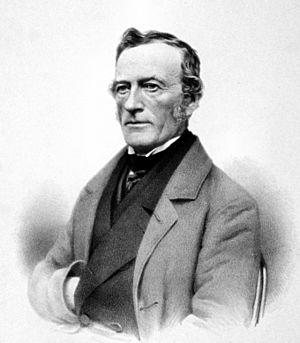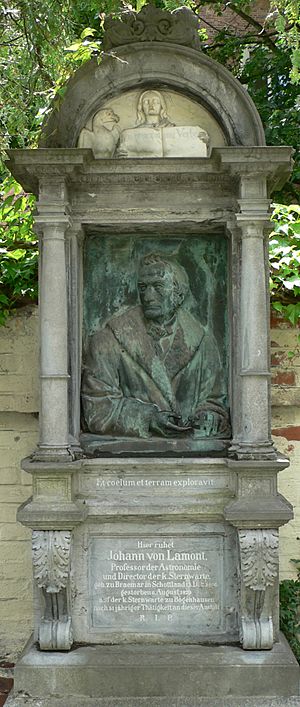Johann von Lamont facts for kids
Quick facts for kids
Johann von Lamont
|
|
|---|---|

Lamont in 1856
|
|
| Born | 13 December 1805 Corriemulzie, Scotland
|
| Died | 6 August 1879 (aged 73) Munich, Germany
|
| Known for | Magnetism of the Earth |
| Scientific career | |
| Fields | Astronomy, physics |
| Doctoral students | Philipp Carl |
Johann von Lamont, originally named John Lamont, was a brilliant Scottish-German astronomer and physicist. He was born on December 13, 1805, and passed away on August 6, 1879. He is most famous for his important discoveries about the Earth's magnetism.
A Life of Discovery
Johann Lamont was born in a small place called Corriemulzie in Scotland. His father worked as a forester, looking after forests for a wealthy Earl. John started school in his local village, Inverey.
When he was 12, his father died. John was then sent to a special school in Germany called St James' monastery. This was a Benedictine college, which is a type of religious school.
After finishing school, Johann began working in astronomy. He joined the Bogenhausen Observatory and became its director in 1835. A director is like the head of an organization. He also earned his doctorate degree in 1830 and became a professor of astronomy at Munich University in 1852.
At the observatory, he worked on a huge project. He created a detailed list of stars, called a star catalog, which included about 35,000 entries!
In 1845, he was recognized for his work. He became an Honorary Fellow of the Royal Society of Edinburgh, a famous group of scientists.
Earth's Magnetism
Lamont's most important work was studying the magnetism of the Earth. He traveled to many places, including Bavaria, northern Germany, France, Spain, and Denmark, to measure the Earth's magnetic field.
He made an amazing discovery: the Earth's magnetic field changes in a pattern that repeats every ten years. This is called a "decennial period." He also found that electric currents inside the Earth create this magnetic field. This ten-year cycle he found was very similar to the eleven-year cycle of sunspots, which are dark spots on the Sun.
Studying Planets
Johann von Lamont also calculated the paths, or orbits, of the moons orbiting Uranus and Saturn. He was the first to figure out how much Uranus weighed.
Interestingly, he saw the planet Neptune by chance in 1845 and twice in 1846. However, he didn't realize it was a new planet at the time.
Johann von Lamont never married or had children. He died in Munich, Germany, on August 6, 1879. He left a lot of money to create scholarships. These scholarships help students study sciences. He is buried in the Bogenhausen Churchyard in Munich.
Awards and Recognition
Johann von Lamont received many honors for his scientific work. These included being a Foreign Member of the Royal Society and a Fellow of the Royal Society of Edinburgh.
In 1867, the King of Bavaria gave him the Merit Order of the Bavarian Crown. This special award meant that Lamont was given the title "von," which made him a nobleman.
There is a statue on his tomb in Munich. Locals sometimes put small coins into its open hand. In 1934, a granite memorial was built in his memory in Scotland, near where he was born.
Two features in space are named after him:


